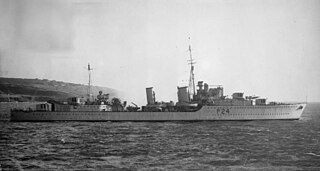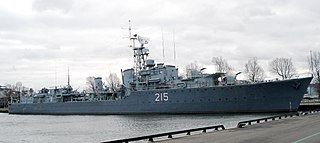Related Research Articles
Eight ships of the Royal Navy have been named HMS Ardent, whilst another two were planned:
Two ships of the Royal Navy have borne the name HMS Afridi, after the ethnic group, the Afridi:
Nine ships of the Royal Navy have been named HMS Amazon, after the mythical female warriors.

HMS Maori was a Tribal-class destroyer named after the indigenous Māori people of New Zealand. She served with the United Kingdom Mediterranean Fleet during World War II until she was bombed and sunk by German aircraft while at Malta in 1942. Her wreck was later raised and scuttled outside the Grand Harbour. The wreck is now a dive site.
Three ships of the Royal Navy have been named HMS Gurkha, while two have been named HMS Ghurka, after a people who originate in Nepal and who serve with distinction in the British Army as part of the Brigade of Gurkhas.
Thirteen vessels of the Royal Navy have borne the name HMS Mohawk, after the Mohawk, an indigenous tribe of North America:
Two ships of the British Royal Navy have been named HMS Eskimo:

The Tribal class, or Afridi class, were a class of destroyers built for the Royal Navy, Royal Canadian Navy and Royal Australian Navy that saw service in World War II. Originally conceived during design studies for a light fleet cruiser, the Tribals evolved into fast, powerful destroyers, with greater emphasis on guns over torpedoes than previous destroyers, in response to new designs by Japan, Italy, and Germany. The Tribals were well admired by their crews and the public when they were in service due to their power, often becoming symbols of prestige while in service.
Five ships of the Royal Navy have been named HMS Achates after Achates, a character in Roman mythology. A sixth was planned but never completed:
Six ships of the Royal Navy have borne the name HMS Cossack, after the Cossack people of Eastern Europe, whilst another was begun but was cancelled while building:
Five ships of the Royal Navy have been named HMS Hampshire after the English county:
Three ships of the Royal Navy have borne the name HMS Acasta, whilst another two were planned:

HMS Ghurka was a Tribal-class destroyer built in 1907 for the Royal Navy. She served as part of the Dover Patrol during the First World War, playing a part in the sinking of the German submarine U-8 in 1915, and was sunk by a German mine in 1917.
Three ships of the Royal Navy have borne the name HMS Sikh, after the Sikhs, who formed a large part of the community in the Punjab region during British rule there:
Two ships of the Royal Navy have been named HMS Viking, after the Vikings, whilst another Viking was in service with the Royal New Zealand Navy:
Three ships of the Royal Navy have borne the name HMS Crusader, after the participants in the Medieval Crusades:
Māori or Maori can refer to:
The following index is provided as an overview of and topical guide to Wikipedia's articles on recreational dive sites. The level of coverage may vary:

Recreational dive sites are specific places that recreational scuba divers go to enjoy the underwater environment or for training purposes. They include technical diving sites beyond the range generally accepted for recreational diving. In this context all diving done for recreational purposes is included. Professional diving tends to be done where the job is, and with the exception of diver training and leading groups of recreational divers, does not generally occur at specific sites chosen for their easy access, pleasant conditions or interesting features.
References
- Colledge, J. J.; Warlow, Ben (2006) [1969]. Ships of the Royal Navy: The Complete Record of all Fighting Ships of the Royal Navy (Rev. ed.). London: Chatham Publishing. ISBN 978-1-86176-281-8.